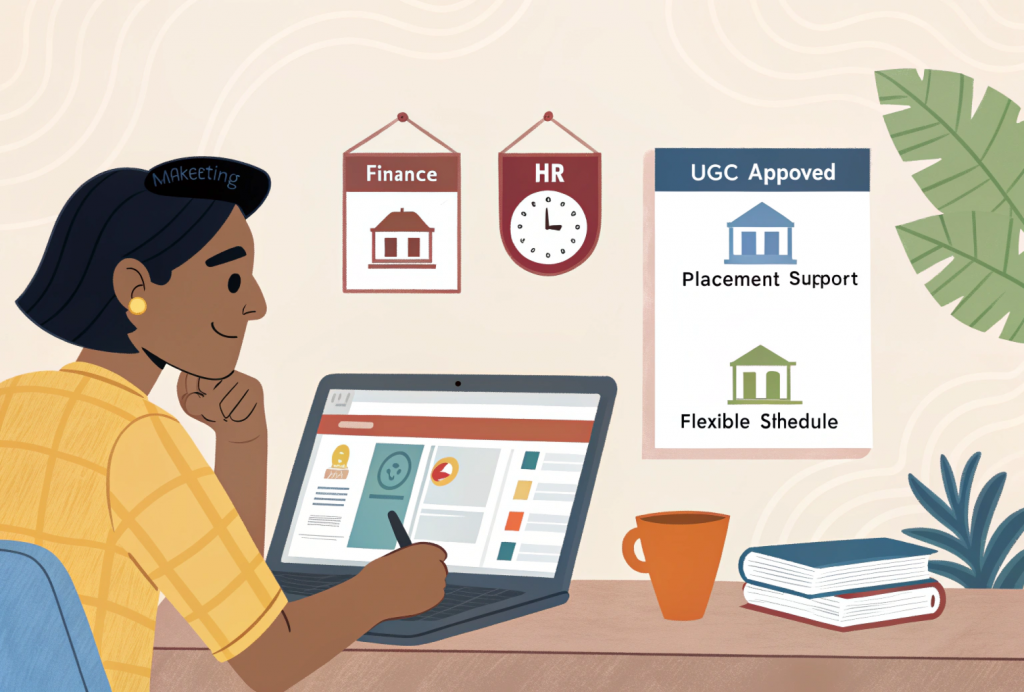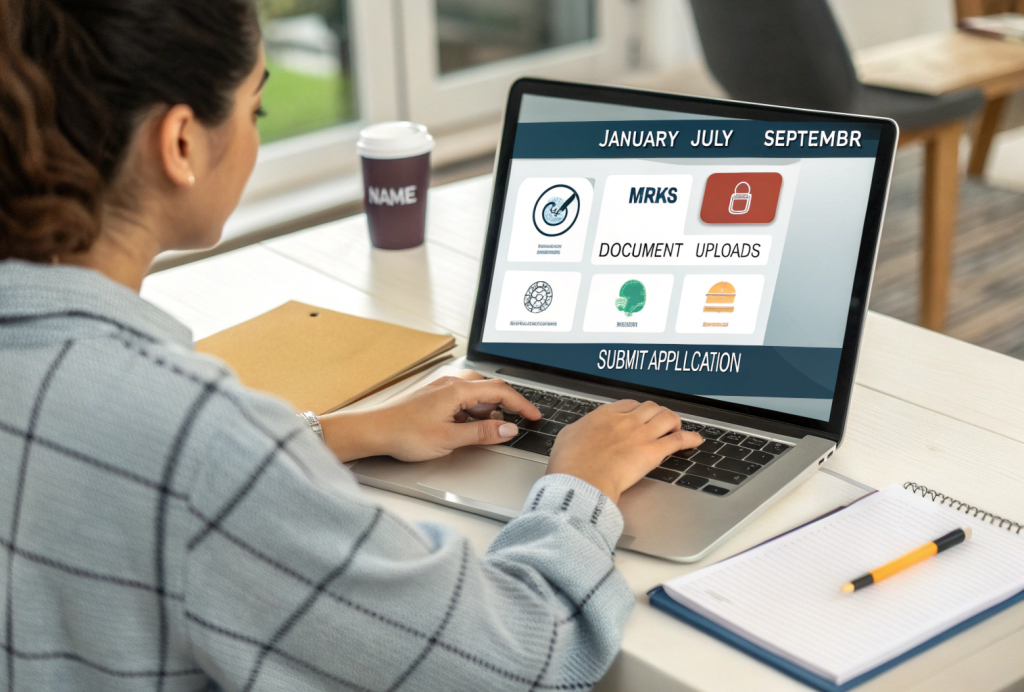An online MBA is a great option for anyone who wants to grow in their career without quitting their job or relocating. With flexible schedules, affordable fees, and the ability to learn from anywhere, online MBA programs in India have become increasingly popular—especially those offered by UGC-approved universities. If you’re wondering how to apply for online MBA in India, this guide will walk you through every step. These programs are designed for today’s learners who want to balance education with work or other responsibilities, without compromising on quality. Many employers now recognize online degrees, making them a smart and practical choice.
Whether you’re a working professional aiming for a promotion, a recent graduate exploring options, an entrepreneur wanting to boost your business skills, or even a parent planning to re-enter the job market—an online MBA can work for you. It’s all about having the right mindset, a reliable internet connection, and the motivation to learn. If that sounds like you, you’re already on the right track!
Step 1: Research and Shortlist MBA Programs(How to apply for online mba)

Before you jump into applying, take some time to explore your options. Start by looking for UGC-approved universities, because these are officially recognized and their degrees hold real value. You can check the UGC-DEB (Distance Education Bureau) website to see which universities are legit. Make a list of a few that have a good reputation, strong placement support, and positive student reviews.
Next, think about what kind of MBA you want to do. Do you want to specialize in Marketing, Finance, HR, Business Analytics, or maybe even something like Digital Marketing or Healthcare? Every university offers different specializations—so choose one that matches your career goals. Also, compare the fees, course duration, and how flexible the classes are. Some programs offer weekend live classes, while others are fully self-paced. Pick the ones that suit your schedule and budget the best.
Step 2: Check Eligibility Criteria

Once you’ve shortlisted a few online MBA programs, it’s time to check if you meet their basic requirements. Don’t worry—it’s usually not too complicated. Most universities have simple eligibility criteria, especially for online programs. But it’s important to go through the details before applying, so you don’t get stuck later.
Here are some common eligibility requirements to look out for:
- Bachelor’s degree from a recognized university (in any stream)
- Minimum marks: Usually 50% in graduation (some allow 45% for reserved categories)
- Work experience: Some programs (especially Executive MBAs) may require 1–2 years of experience
- Entrance exams: A few universities might ask for CAT, MAT, or their own test, but many don’t
- Age limit: Most programs don’t have one—so you can apply even if you’re reskilling later in life
The good news? Online MBA programs are designed to be accessible. If you have a graduation degree and a serious interest in learning, chances are you’ll meet the eligibility. Just double-check on the university’s official site or brochure to be sure.
Step 3: Gather Required Documents

Now that you know you’re eligible, it’s time to collect all the documents you’ll need for the application process. Don’t wait until the last minute—having everything ready in advance will make the whole process faster and stress-free. Most universities ask for a few standard documents, and the list is usually pretty similar across different programs.
Here are the common documents you’ll need:
- Graduation mark sheets and degree certificate
- Class 10 and 12 mark sheets (some universities ask for these too)
- ID proof like Aadhar card, PAN card, or passport
- Passport-sized photograph (digital format)
- Work experience letter or proof (only if the program asks for it)
- Entrance exam scorecard (if applicable)
Once you have all these documents scanned and saved (preferably in PDF or JPEG format), you’ll be ready to move on to the application stage. Keep everything organized in one folder on your computer or phone, so you can upload them easily when filling out the form.
Explore our online programs to become future-ready
Transform your career with industry-aligned courses designed by experts.
Step 4: Understand the Application Process

Once your documents are ready, the next step is to actually apply to the program—and thankfully, most online MBA applications in India are super simple. Nearly all universities offer online applications, so you can complete the whole process from your laptop or even your phone. You’ll need to register on the university’s admission portal, fill out the form with your personal and academic details, upload the required documents, and make the payment—all in one go. Some universities still offer offline options, like submitting forms at their campus or study centers, but online is definitely the faster and more convenient route.
Make sure to check the application deadlines and intake cycles before you begin. Many universities have multiple intakes throughout the year—like January, July, or September—so if you miss one, you don’t have to wait an entire year. But don’t delay either—early applications often get processed faster and may give you access to special offers like fee waivers or scholarships.
And yes, don’t forget about the application fee. It’s usually somewhere between ₹500 to ₹1500 depending on the university. This is non-refundable, so double-check everything before hitting that submit button. Once done, you’ll either get a confirmation email or be able to track your application status online.
Step 5: Fill Out the Application Form

This is where things get real—you’re now ready to actually fill out the application form. Don’t worry, it’s usually a pretty straightforward process. Just make sure you’re in a distraction-free space, have all your documents ready, and take your time with each section. Rushing through can lead to small mistakes that might delay your admission.
Here’s a simple step-by-step breakdown of what to expect:
- Create an account on the university’s official admission portal
- Start a new application and fill in your personal details (name, DOB, contact info)
- Enter your academic information like marks, degree, and year of passing
- Upload scanned copies of required documents in the correct format and size
- Choose your preferred specialization (if required)
- Review your application carefully before submitting
- Pay the application fee using available payment options (UPI, card, net banking)
And here are some common mistakes you should try to avoid:
- Spelling errors in your name or email address
- Uploading blurry or wrong documents
- Leaving required fields blank or incomplete
- Choosing the wrong course or intake by mistake
- Forgetting to hit the final “Submit” button
Take your time and double-check everything. A well-filled form makes a good first impression and ensures your application moves forward without hiccups.
Step 6: Submit Documents and Pay Fees
After filling out the application form, the next step is to upload your documents and make the payment. Most universities will guide you through this right on the application portal, so it’s pretty simple. Just make sure all your documents—like mark sheets, ID proofs, and photos—are scanned clearly and saved in the required format (usually PDF or JPEG). Avoid uploading blurry files or the wrong documents, as this can lead to delays in your application review.
When it comes to payments, universities usually offer multiple options like debit/credit cards, UPI, net banking, or even wallets. Choose whichever method you’re most comfortable with, but be sure to complete the payment in one go—partial payments usually aren’t allowed. Once everything is submitted and paid, you should receive a confirmation message or email. Save that confirmation for your records—it’s proof that your application was received successfully.
Step 7: Attend Interview or Entrance Exam (If Applicable)
Not all online MBA programs require an entrance exam or interview, but some do—especially if you’re applying to a top-tier university or an executive MBA. If your chosen program has this step, don’t stress! With the right preparation, you’ll do just fine. Most of these processes are now fully online, which makes them much easier to attend from anywhere.
Here’s what to expect if you have an interview:
- You’ll usually get a scheduled date and time via email
- The interview may happen over Zoom, Google Meet, or another video platform
- Questions are often basic—like your career goals, why you chose MBA, or how you plan to manage time
- Dress neatly, sit in a quiet space, and keep your documents nearby just in case
And if there’s an entrance exam involved, keep these tips in mind:
- Most online exams are aptitude-based (quant, reasoning, English, etc.)
- Use sample papers or mock tests to practice in advance
- Make sure your internet connection is stable and your device is fully charged
- Read the instructions carefully before you begin the test
The key is to stay calm and confident. These steps are not meant to scare you—they just help the university understand whether you’re a good fit for the program. A little prep goes a long way.
Step 8: Await Confirmation & Admission Offer
Once you’ve submitted your application, documents, and payment, it’s time to sit back and wait for the university to process everything. Most universities will first send a provisional admission offer, which means they’ve accepted your application based on the information you’ve provided. This offer may be subject to final document verification or fee clearance.
The timeline for confirmation can vary—some universities send out offers within a few days, while others may take a couple of weeks. You’ll usually receive updates via email or through the admission portal, so keep checking regularly. Once everything is verified, you’ll get your final admission letter, which officially confirms your seat in the program. That’s when you can start getting excited—because your MBA journey is about to begin!
Step 9: Complete Enrollment & Start Learning
Congrats! Once you receive your final admission letter, the next step is to complete your enrollment and get ready to begin your classes. This is where things start to feel real. Most universities guide you through the onboarding process step by step, so don’t worry—you won’t be left on your own.
Here’s what usually happens after admission:
- You’ll be invited to an online orientation session where the university explains how the program works, who to contact for support, and what to expect over the next few months.
- You’ll get access to the Learning Management System (LMS)—this is your digital classroom. It’s where you’ll find recorded lectures, reading material, live class links, discussion forums, assignments, and more.
- The university will also share an academic calendar, which includes your class schedule, exam dates, assignment deadlines, and semester breaks.
Once you’re logged into the LMS and have your calendar, you’re all set to begin your online MBA journey. Make sure to explore all the features and stay organized from day one. It might feel a little new at first, but once you get used to the flow, it becomes super manageable—and actually fun to learn at your own pace!
Bonus Tips for a Smooth Application Journey
Even though applying for an online MBA is pretty straightforward, a few smart moves can make the whole process even smoother. First, don’t hesitate to reach out to admission counselors. Most universities have a dedicated team just for this, and they can help you with anything—from program details to form-filling doubts. They’re super helpful and it’s literally their job to guide you.
Also, keep an eye out for scholarships or EMI options. Many universities offer partial fee waivers for early applicants, working professionals, or students from specific categories. And if you’re worried about paying the full fee upfront, ask about EMI or installment plans—they’re more common than you’d think. Lastly, take a few minutes to read alumni reviews or watch student testimonials online. It’ll give you a real sense of what the program is like and help you make a confident, informed decision.
Conclusion
Applying for an online MBA in India might seem like a big task at first, but once you break it down step by step, it becomes totally manageable. With the right research, a little prep, and a clear plan, you can smoothly complete the entire process—from shortlisting universities to starting your first online class. Whether you’re looking to switch careers, grow in your current role, or simply upgrade your skills, an online MBA can be a powerful step forward. So go ahead, take that leap—your future self will thank you for it!


Leave a Reply